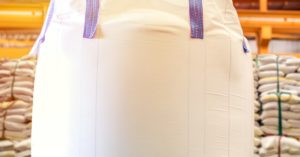The Complete History of Jumbo Bags

There was a time when manufacturers and distributors used to struggle with finding the safest and most economical way to transport materials. Sure, there were Gaylord boxes and paper-based containers, but they weren’t the best solutions in carrying fine powders or chemicals.
But as they say, every problem has a solution.
The solution in this case was FIBC bags or flexible intermediate bulk containers. Also known as jumbo bags, PP woven bags, and bulk bags, FIBCs are the ultimate industrial containers that can store pretty much anything you want – fresh produce, refined flours, dry cement, sand, drugs, fertilizers, chemicals, and more.
These sturdy, reliable bags are used by most manufacturers today, across many industries. In this article, we are going to touch briefly at how that came to be.
FIBCs in the 1950s
It’s hard to say exactly when FIBC bags were created, but it happened sometime around the late 1950s. At this time, these bulk bags were mostly used by the Japanese and European industries and were yet to come to the US.
The first-ever FIBC bags were quite different from the modern bags you see today. These old versions used to be made from PVC (polyvinyl chloride) coated polyester or nylon fabric sheets and then welded together. Although these bags could carry a lot of weight, they were very expensive back then.
In order to cut down the costs, the FIBC manufacturers started using the woven polypropylene resin that’s still being used today.
By the 1970s, FIBC bulk bags had started catching the eye of many countries. As the Middle-Eastern countries began importing cement from Spain, Italy, and Northern Europe, the demand for FIBCs also grew.
Then sometime in the 1980s, the US Department of Transportation granted various exemptions that allowed jumbo bags to handle hazardous materials. This encouraged the chemical, pharmaceutical, and waste-disposal industries to start using FIBC bags for more efficient and safer operations.
The Modern FIBC Bags
It is estimated that FIBCs are used to transport over a quarter of a billion tons of goods every year, across different industries. The FIBC industry is growing at a rapid pace; nearly 50 million bulk bags were used in the US in 2017 alone.
In addition to store and carry products, FIBC bags are also used as sandbags for preventing floods and water damage in various parts of the world.
These multipurpose bags are strong yet lightweight and can easily carry 4,000+ pounds of bulk materials. And they are easy to handle. FIBCs are designed with handles or straps so they can be easily filled and discharged completely using forklifts, hooks, or other methods of suspension.
Perfect Packaging Solution
When not in use, you can fold the FIBC bags and store them all in a very limited space, saving you storage area and the associated fees. These bags are economical in many ways and can be customized to suit your needs. And as if that wasn’t enough, FIBCs are recyclable as well.
Can you think of a more perfect packaging solution in the modern world?
Our worldwide network of distribution centers means you don’t have to worry about whether your FIBCs will arrive on time. To learn more, call us today at (706) 737-7999 or contact us online.





